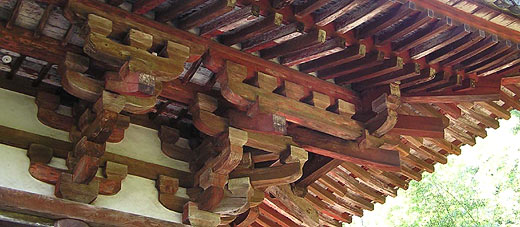|
||
 |
||

Taimadera Toutou 当麻寺東塔 (Kyoto)
(C)2001 Japanese Architecture and Art Net Users System. No reproduction or republication without written permission.
掲載のテキスト・写真・イラストなど、全てのコンテンツの無断複製・転載を禁じます。
|
||||||
| mitesaki tokyou 三手先斗きょう | ||||||
| KEY WORD : architecture / general terms | ||||||
| Sometimes called mitesakigumi 三手先組. A three-stepped-bracket complex composed of three projecting sets of bracket arms *hijiki 肘木, each supporting three small bearing blocks *makito 巻斗. Each set projects a step further from the wall plane. A tail rafter *odaruki 尾垂木, extends from the interior, passes through the center bearing block of the two-stepped bracket complex *futatesakigumi 二手先組, which supports the long bracket tie beam *tooshihijiki 通し肘木. This beam, in turn, carries the third bracket complex, mitesaki 三手先, fairly close to the end of its tail. This complex receives the eave purlin *gagyou 丸桁. To enclose otherwise unsightly gaps, a narrow ceiling kotenjou 小天井, is hung between the wall purlin and the two-stepped bracket complex. Short curved non-supporting ribs *shirin 支輪, are positioned between the top of the two-stepped complex and the eave purlin. If the curved ribs are omitted, the narrow ceiling is extended from the wall purlin to the eave purlin. This type of stepped-bracket complex is the most frequently found in Japanese style architecture *wayou 和様. | ||||||
 Taimadera Toutou 当麻寺東塔 (Kyoto)
|
||||||
| REFERENCES: | ||||||
| EXTERNAL LINKS: | ||||||
| NOTES: | ||||||
(C)2001 Japanese Architecture and Art Net Users System. No reproduction or republication without written permission. 掲載のテキスト・写真・イラストなど、全てのコンテンツの無断複製・転載を禁じます。 |
||||||